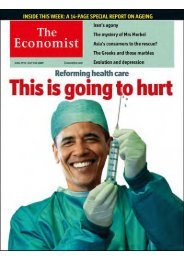Untitled - the ultimate blog
Untitled - the ultimate blog
Untitled - the ultimate blog
You also want an ePaper? Increase the reach of your titles
YUMPU automatically turns print PDFs into web optimized ePapers that Google loves.
Economics focus<br />
Cause and defect<br />
Aug 13th 2009<br />
From The Economist print edition<br />
Instrumental variables help to isolate causal relationships. But <strong>the</strong>y can be taken too far<br />
Illustration by Jac Depczyk<br />
“LIKE elaborately plumed birds…we preen and strut and display our t-values.” That was Edward Leamer’s<br />
uncharitable description of his profession in 1983. Mr Leamer, an economist at <strong>the</strong> University of California<br />
in Los Angeles, was frustrated by empirical economists’ emphasis on measures of correlation over<br />
underlying questions of cause and effect, such as whe<strong>the</strong>r people who spend more years in school go on<br />
to earn more in later life. Hardly anyone, he wrote gloomily, “takes anyone else’s data analyses seriously”.<br />
To make his point, Mr Leamer showed how different (but apparently reasonable) choices about which<br />
variables to include in an analysis of <strong>the</strong> effect of capital punishment on murder rates could lead to <strong>the</strong><br />
conclusion that <strong>the</strong> death penalty led to more murders, fewer murders, or had no effect at all.<br />
In <strong>the</strong> years since, economists have focused much more explicitly on improving <strong>the</strong> analysis of cause and<br />
effect, giving rise to what Guido Imbens of Harvard University calls “<strong>the</strong> causal literature”. The techniques<br />
at <strong>the</strong> heart of this literature—in particular, <strong>the</strong> use of so-called “instrumental variables”—have yielded<br />
insights into everything from <strong>the</strong> link between abortion and crime to <strong>the</strong> economic return from education.<br />
But <strong>the</strong>se methods are <strong>the</strong>mselves now coming under attack.<br />
Instrumental variables have become popular in part because <strong>the</strong>y allow economists to deal with one of <strong>the</strong><br />
main obstacles to <strong>the</strong> accurate estimation of causal effects—<strong>the</strong> impossibility of controlling for every last<br />
influence. Mr Leamer’s work on capital punishment demonstrated that <strong>the</strong> choice of controls matters<br />
hugely. Putting too many variables into a model ends up degrading <strong>the</strong> results. Worst of all, some relevant<br />
variables may simply not be observable. For example, <strong>the</strong> time someone stays in school is probably<br />
influenced by his innate scholastic ability, but this is very hard to measure. Leaving such variables out can<br />
easily lead econometricians astray. What is more, <strong>the</strong> direction of causation is not always clear. Working<br />
out whe<strong>the</strong>r deploying more policemen reduces crime, for example, is confused by <strong>the</strong> fact that more<br />
policemen are allocated to areas with higher crime rates.<br />
Instrumental variables are helpful in all <strong>the</strong>se situations. Often derived from a quirk in <strong>the</strong> environment or<br />
in public policy, <strong>the</strong>y affect <strong>the</strong> outcome (a person’s earnings, say, to return to <strong>the</strong> original example) only<br />
through <strong>the</strong>ir influence on <strong>the</strong> input variable (in this case, <strong>the</strong> number of years of schooling) while at <strong>the</strong><br />
same time being uncorrelated with what is left out (scholastic ability). The job of instrumental variables is<br />
to ensure that <strong>the</strong> omission of factors from an analysis—in this example, <strong>the</strong> impact of scholastic ability on<br />
<strong>the</strong> amount of schooling—does not end up producing inaccurate results.<br />
-118-








![[ccebbook.cn]The Economist August 1st 2009 - the ultimate blog](https://img.yumpu.com/28183607/1/190x252/ccebbookcnthe-economist-august-1st-2009-the-ultimate-blog.jpg?quality=85)



![[ccebook.cn]The World in 2010](https://img.yumpu.com/12057568/1/190x249/ccebookcnthe-world-in-2010.jpg?quality=85)
![[ccemagz.com]The Economist October 24th 2009 - the ultimate blog](https://img.yumpu.com/5191885/1/190x252/ccemagzcomthe-economist-october-24th-2009-the-ultimate-blog.jpg?quality=85)